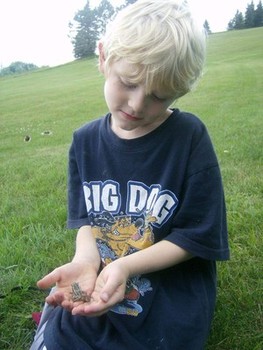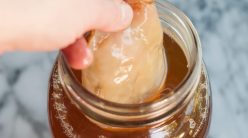
Summer is in full swing and it’s the perfect time to start up a little outdoor summer science.
Don’t worry, this kind of science fun doesn’t require much on your part at all!
Here’s all you need to get your kiddos experimenting, making concoctions and learning along the way.
Test hypotheses. You hear all sorts of folk wisdom that can be great fun for kids to test out. When we heard that you should draw chalk lines outside your house to keep ants in (supposedly because ants won’t cross a chalk line), that was a perfect opportunity for my oldest daughter to draw some chalk mazes around ants in the driveway. She even got an ant to run the maze! (I’ll post the video of it here soon.)
Or how about vinegar at getting rid of weeds, or egg shells repelling slugs in the garden? There are so many experiments to set up in the garden and around the house.
Put out some ingredients. Summer is great because you can make the messes outside and they’re so easy to clean up! Find a shady place outside to put out a variety of harmless kitchen ingredients and invite the kids to experiment. Baking soda and vinegar and classics, but put out baking soda and some other acids (such as lemon juice) and neutral solutions (such as water) and challenge the kids to determine if they’re acid based on how they react.
Corn starch and water make oobleck (mix in equal parts), a fun concoction that reacts as a solid or liquid depending on how you touch it. Invite the kids to make some up and then see what happens if various objects are dropped on it.
Other simple materials can also make for easy science fun. Give the kids an old shirt to stain in a variety of ways (grass, mud, ketchup, ink…) and then some dishes of various cleaning solutions (such as dish soap, bar soap, laundry detergent, stain remover, water and hydrogen peroxide). Let them see which solutions do the best job on which stains.
Even a bowl of flour can make for fun science. Hold objects up above it and drop them to see what sort of crater patterns they can create. Kitchen cabinets contain oodles of possibilities.
Use nature. The sun can make for all sorts of good experiments and projects. For instance, ask the kids to put various objects on a dark piece of construction paper and leave it in the sun. Put several in several parts of the yard (and one inside by a window) and guess which ones will fade the most. Use thin boards to make a design on the grass, leave it for a couple of days and see if it makes a pattern.
Also use the garden, outdoor creatures and other elements of nature. Let kids catch fireflies in a jar and observe them before letting them go. Let them dig up weeds, pot them up, and experiment with how various soil and water additions affect them. How can they make a weed grow bigger and stronger than the rest without chemical fertilizer? What effect will pruning side shoots have on its eventual height compared to a control plant?
Use your imagination (and theirs). Try to find some sort of science starter each day and let the kids take it from there. They may need you to get the ball rolling — such as putting out some cool materials or throwing out some ideas — and then let them decide on their own how to run with it.
Take some pictures, and they’ll have material to make up some fun lapbooks, blog posts or scrapbook reports about it on those rainy or cold days to come!
***
Want to support our site?
Treat yourself to something on Amazon!
You deserve it, and it will help us out.
It’s a win-win! 😉
This site is an affiliate for Amazon.com. Purchases made through this link will earn us a small commission, at no extra charge to you.
***
This article originally appeared on examiner.com





